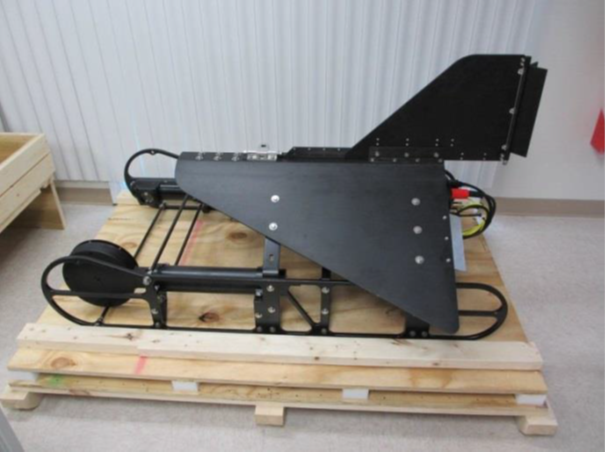You are here
Video Plankton Recorder (VPR)
The Video Plankton Recorder (VPR) project aims to determine the spatio-temporal dynamics of abundance and diversity of zooplankton in the Belgian Part of the North Sea (BPNS) in function of the various changing environmental conditions (temperature, nutrients, pH).
General
Zooplankton is of great importance to our marine ecosystems. They play a role in the biogeochemical cycles and form a crucial link between the phytoplankton and higher tropic levels to which e.g. economic important fish species belong. Most zooplankton species are short-living, have a quick generation time and are sensitive to temperature fluctuations. With climate change, rising sea temperatures and ocean acidification, this makes them highly suitable organisms to monitor the effects of anthropogenic influences.
As part of the marine LifeWatch observatory, a VPR was added to the set of high-throughput imaging sensors that can be used to observe and understand zooplankton and its dynamics in the marine ecosystem. The VPR is essentially an underwater microscope which records images of particles from 100µm up to a few centimeters. As photographs are made in the water column, the VPR has the advantage that it can observe living and delicate plankton such as gelatinous zooplankton (e.g. jellyfish), colonial forming organisms and other fragile particles (e.g. marine snow) that otherwise could collapse or be destroyed during traditional net sampling. The VPR can be used in conjunction with CTD measurements, to determine the relative contribution of various changing environmental conditions on the spatio-temporal dynamics of plankton. The VPR can be deployed in an undulating way, moving up and down through the water column. The collected images can be linked to location and depth, which enable us to investigate vertical distribution of marine organisms and to research the fine scale resolution of plankton distribution. Furthermore, having the plankton sample in a digital format allows accelerating the classification procedure.
Infrastructure
The VPR was developed at Woods Hole Oceanographic Institution (WHOI). The VPR frame is equipped with a real-time high resolution underwater digital camera system (Digital CCD camera; 1,5 Mpixel monochrome; 30 Hz) and strobe (20 W; 30 Hz; 3 µs). Image acquisition is 25 frames/second, while the volume of sampled water can be selected with different settings. Four settings can be used, ranging from small but highly detailed frames (8.8*6.6 mm) to very large and less detailed frames (46.5*34.5 mm). Exact volumes of water can be calculated with a calibration of tow speed and frame. Furthermore, also a Seabird Inc. FastCat CTD (conductivity-temperature-depth sensor) and a turbidity sensor are mounted to the VPR frame.
|
During measurements, the VPR is towed behind the RV Simon Stevin through the stern A-frame, on a dedicated winch and at a speed of 4-5 knots. The device is built to take real-time images of zooplankton and particulate matter, and transfer these to the deck unit through a 300 m single mode optic cable. On this deck unit, Regions Of Interest (ROI) are extracted from original photos. These data are linked with several abiotic factors, e.g. Temperature, Turbidity and Conductivity, which are logged by the CTD mounted on the VPR. |
|
|
|
|
|
|
||
Left: side view of the VPR (©VLIZ) - Middle: VPR being deployed at the start of a track (©VLIZ) - Right: VPR prepared for deployment aboard the RV Simon Stevin (©VLIZ)
PhD Project
The VPR is a key instrument in a PhD study that is part of the VLIZ research activities and is designed in cooperation with the Marine Biology Research Group of Ghent University: “Optical imaging and analysis for zooplankton observations”.
The PhD study, which started in September 2019, can be separated into two main parts. The first part is more technical and wants to assess the applicability of the VPR in the BPNS for long-term monitoring of zooplankton and compare the efficiency of the VPR for measuring plankton diversity with more traditional methods. The BPNS is characterized by a higher turbidity than the clear Arctic and Atlantic waters of other VPR studies. The operational limits of the VPR will be tested because high turbidity may hamper the efficient use of the VPR. In the second ecological part research will be conducted on the food quality of copepods in the BPNS.
Since 2020, the VPR is used on a regular basis during the LifeWatch sampling campaigns..

Compilation of Video Plankton Recorder images obtained during several LifeWatch sampling campaigns. From upper left to bottom right: Branchiolaria (Asteroidea larva), Echinopluteus (Echinoidea larva), Acartia (Centropages); jellyfish, sole larva; Noctiluca, Echinopluteus, Cumacea, Calanoidea (Calanus helgolandicus), jellyfish, Calanoidea (Temora longicornis), Porcellinidae larva, Appendicularia: Oikopleura dioica, Brachyura larvae (©Jonas Mortelmans).
Useful links
- LifeWatch Data Explorer - Zooplankton data: Access and explore the LifeWatch data.
Most recent publications
- Ollevier, A.; Mortelmans, J.; Vandegehuchte, M.; Develter, R.; De Troch, M.; Deneudt, K. (2022). A Video Plankton Recorder user guide: Lessons learned from in situ plankton imaging in shallow and turbid coastal waters in the Belgian part of the North Sea. J. Sea Res. 188: 102257. https://dx.doi.org/10.1016/j.seares.2022.102257 [link to IMIS record]
- Hablützel, P.I.; Rombouts, I.; Dillen, N.; Lagaisse, R.; Mortelmans, J.; Ollevier, A.; Perneel, M.; Deneudt, K. (2021). Exploring new technologies for plankton observations and monitoring of ocean health, in: Kappel, E.S. et al. Frontiers in ocean observing: Documenting ecosystems, understanding environmental changes, forecasting hazards. Oceanography, Suppl. 34(4): pp. 20-25. https://dx.doi.org/10.5670/oceanog.2021.supplement.02-09 [link to IMIS record]



